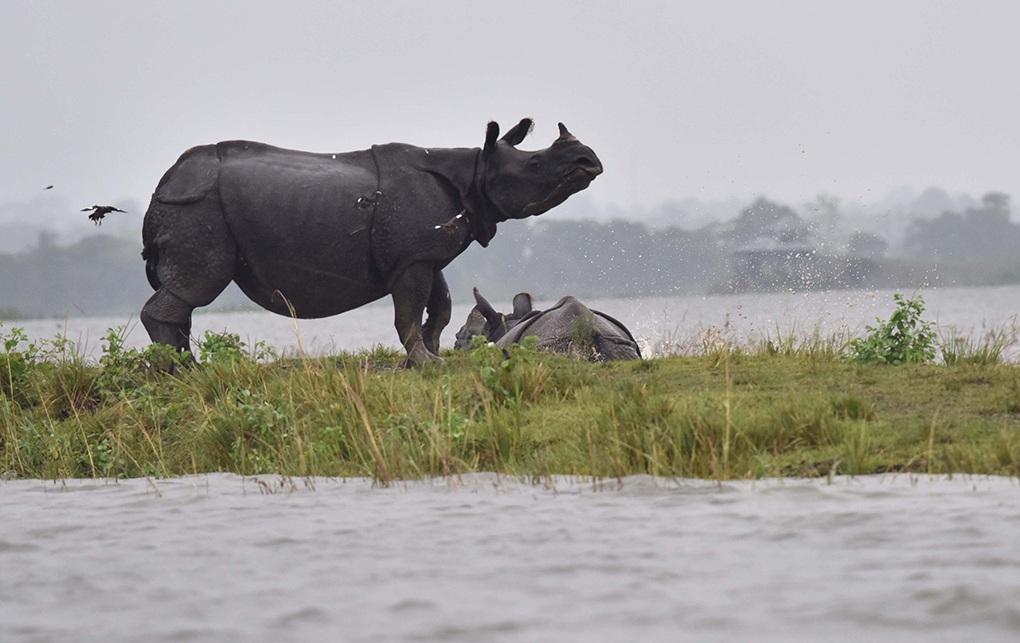Safeguarding single horn rhinoceros in highly protected reserve forests in Assam confronts a major challenge other than the poaching and that’s the perennial flood hitting northeast India annually. Often poaching of a one-horned rhino makes international media headlines, but it gets subdued attention when significant numbers of precious rhinos are wiped out in a single wave of flood caused by incessant rains for days in the vicinity of upper riparian countries. The latest wave of Assam flood snatched away the lives of 13 rhinos, whereas it took six years to lose 11 grass-eating pachyderms to poachers inside the forest reserves. Statistics reveal that Assam recorded unnatural deaths of over 50 rhinos due to flood related disasters since 2019. So survival of the precious animals may not solely depend on the strict anti-poaching measures, but pragmatic initiatives to help rhinos to survive during the perennial floods.
The second wave of flood in July 2024 left a trail of devastation in Assam by killing over a hundred people and temporarily displacing thousands of families to take shelter in administration run relief camps. At its peak, the deluge hit over 2.7 million people (out of 33 million population) in 30 districts, where more than 3500 villages were submerged by the flood water for many weeks. The muddy flood water from Brahmaputra, Barak, Kushiyara, Subansiri, Burhi Dihing, Dikhou, Disang, Dhansiri, Jia-Bharali, Puthimari, Kapili, Beki, Manas, Dhaleswari, Pagladiya, Burhadiya, etc rivers inundated over 25,000 hectares of crop area across the region. The natural disaster damaged a number of embankments, roads & bridges, buildings and other infrastructures. It also devastated over 10,50,000 domestic animals & poultry, whereas hundreds of wild animals lost their lives in Kaziranga National Park and Tiger Reserve.
The authority in Kaziranga reveals that at least 215 wild animals including 13 rhinos and 170 deer, 8 porcupines, 5 pigs, 1 buffalo died in the forest reserve due to drowning and other causes. No less than 157 animals including two rhino calves were rescued by the staff on duty and later most of them were released to the wild after necessary treatment. Kaziranga’s field director Sonali Ghosh informed that most of the forest camps (out of 233) inside the park went under flood water for many days. The UNESCO world heritage site today gives shelter to more than 2600 rhinos along with Asiatic elephants, water buffalo, royal Bengal tigers and a varieties of birds. Once drawn media attention for wrong reasons, Kaziranga drastically reduced the number of poaching incidents in the last few years, thanks to the brutal laws against the poachers, strengthening of ground staff inside the protected forest areas and increasing public awareness in the fringe areas.
The safe habitat for the largest population of greater one-horned rhinos (Rhinoceros unicornis) in the world eventually experiences flooding every year from the inflated water from Brahmaputra river on its northern border. As the core 430 square kilometer area (now extended to 1,300 sq km) goes under the water, the animals take refuge in hundreds of highlands erected inside it. Many animals try to cross the Asian Highway 1 (National Highway-37) on its southern border to climb the hilly areas of Karbi Anglong. While crossing the highway, some animals are killed by the speeding vehicles and hence the authorities instruct the drivers to maintain a safe speed limit to avoid any unwanted incidents. Often the vehicles are escorted by the forest officials while crossing the park to avoid accidents with the fleeing animals.
Rhinos are recognized as vulnerable species by the International Union for Conservation of Nature (IUCN) and India’s wildlife protection act formulated in 1972 gives enormous power to the forest rangers to protect the gigantic animal. The rhino horns, grown by both males and females after attaining six years, are believed to have medicinal values supposed to cure typhoid, headache, stomach ailment, food poisoning, snakebites and even cancer. Taiwan, Thailand, South Korea, Vietnam and the Middle East are also known to be huge markets for rhino horns, where its use for medical purposes and scientific research is legalised. Many also unscientifically believe that one can achieve unusual sexual power with the help of rhino horns (using it as an aphrodisiac/traditional Viagra). However, the veterinarians argue that rhino horns comprise the same protein that constitutes the formation of hair & fingernails and it does not possess any quality for sexual stimulation.
Kaziranga lost two adult rhinos in January 2024 to poachers, who took away the horns understandably to earn an attractive amount of money from the illegal wildlife markets. Last year, Kaziranga witnessed one rhino poaching incident (Manas National Park and Tiger Reserve also lost one rhino to poachers) and it was preceded by two incidents each in 2021 and 2020, whereas three rhinos were killed in 2019. Needless to mention, Assam recorded a zero rhino-poaching year in 2022 to draw the applause from the global conservationists. Another world heritage site of the State, Manas forest reserve currently gives shelter to around 50 rhinos with a host of other inmates like water buffalo, tiger, leopard, golden langur, gaur, pygmy hog, etc. Similarly, Pobitora Wildlife Sanctuary (giving shelter to 107 rhinos) and Orang National Park (125 rhinos) support the rhino population of Assam to increase up to 2,895 individuals.
With a drastic reduction in poaching incidents following the deployment of heavily armed ground forces and other modern gadgets, Assam expects to increase the rhino population to 3,000 very soon. A number of poachers were arrested and many died in encounters with the security forces inside the forest areas. The captured poachers and their associates admit that they had taken the risk of killing rhinos inside the restricted forest reserves because of enormous monetary benefits. While achieving success in preserving the species, it’s time to pay serious attention towards the annual deluge, as it continues washing away rhinos and other animals every year. In a major flood that hit Kaziranga in 2017, over 350 animals including 24 rhinos died due to drowning and colliding with moving vehicles on the highway. It was succeeded by 17 rhino casualties in 2019, 10 in 2020, 8 in 2021, etc due to floods.
But the conservationists argue that Kaziranga inmates cannot survive without the recurrent flood. The flood water helps the ecosystem by depositing nutrients for regenerating the grasslands. The natural water movement also supports cleaning the wetland of many invasive species for the benefit of grass eaters. All wild animals possess instincts to survive during the flood and so move towards the high land, apprehending the surrounding water level in advance. What they need, a natural way to proceed with no or little human interventions, so that they can take the decision correctly to move out and also return back to the forest reserve after the flood water recedes.







